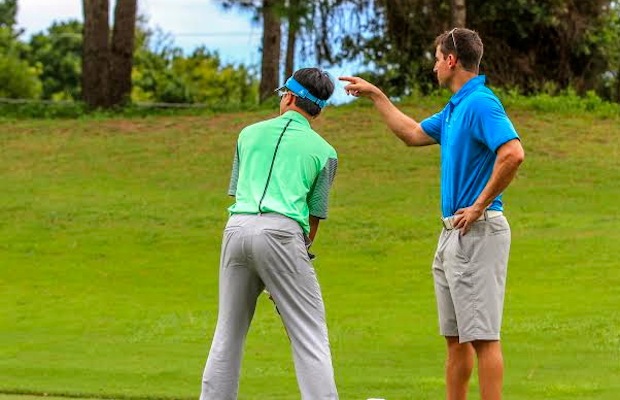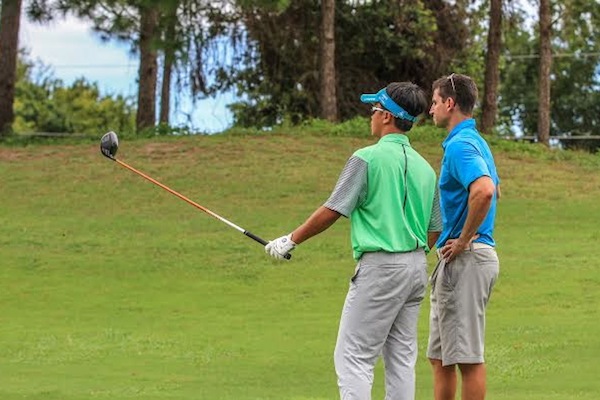Instruction
Focus on what you can control

Every golfer I work with wants one thing: more confidence.
It doesn’t matter whether they are a touring professional or an amateur striving to break 100, every golfer wants confidence.
At the Gary Gilchrist Golf Academy, we use many different mental training strategies to develop and preserve confidence with our golfers. One of the simplest and most powerful methods to building confidence is learning to manage situations by understanding there are certain things you can control and certain things you cannot control.
If you want more self-confidence in golf, it is essential to know what you have control over and what you don’t. Most golfers are harder on themselves than they should be. A lot of this stems from having unrealistic expectations of what you can control and how you react to these situations. The game can be tough enough without the added traction of blaming and belittling yourself. Recognizing factors inside and outside of your control and how to mentally manage these areas can relieve stress and add confidence to your game.
Factors You Can Control
• You can control your preparation for a shot
• You can control your training schedule
• You can control your attitude and outlook
• You can control your work ethic
• You can control your decision making and planning
When you focus on what you can control it provides you enormous power to make decisions and take personal responsibility for your game. When faced with challenges you can focus on solutions and ways to improve your game. For instance, when struggling with an aspect of your game – you control how you react and how you move forward. You can get angry and dejected, or you can seek solutions, continue to work, and stay patient. The latter is the better option and the one you CAN take if you want to see how far you can go in this great game.
Understanding what factors you can control also provides you a great way to build confidence. A major aspect of confidence comes from giving yourself credit and recognizing your accomplishments. For some, giving themselves credit is second nature. For others, giving themselves credit takes conscious effort. Either way, you CAN choose to focus on your successes and build confidence within yourself.
Factors You Cannot Control
• You cannot control if your ball hits a sprinkler head
• You cannot control your playing partners
• You cannot control what another player shoots
• You cannot control the weather
• You cannot control course conditions

The secret to handling factors outside of your control is understanding you cannot control what happens all the time, but you CAN always control how you react.
For instance, having an optimistic outlook toward bad weather is a sure way to gain an advantage over the field. Many golfers will look at the weather and paint a negative picture of it. They’ll say things like, “I hate playing in this weather, this is going to be terrible.” Counterproductive statements like this is a sure recipe to erode confidence and limit your performance. Accepting that you can’t control the weather, but you CAN control your outlook will provide you the best outcome possible. It will also make the game much more fun and keep you confident.
- LIKE4
- LEGIT1
- WOW2
- LOL1
- IDHT1
- FLOP1
- OB1
- SHANK1
Instruction
Clement: Laid-off or perfect fade? Across-the-line or perfect draw?

Some call the image on the left laid off, but if you are hitting a fade, this could be a perfect backswing for it! Same for across the line for a draw! Stop racking your brain with perceived mistakes and simply match backswing to shot shape!
- LIKE0
- LEGIT0
- WOW0
- LOL0
- IDHT0
- FLOP0
- OB0
- SHANK1
Instruction
The Wedge Guy: The easiest-to-learn golf basic

My golf learning began with this simple fact – if you don’t have a fundamentally sound hold on the golf club, it is practically impossible for your body to execute a fundamentally sound golf swing. I’m still a big believer that the golf swing is much easier to execute if you begin with the proper hold on the club.
As you might imagine, I come into contact with hundreds of golfers of all skill levels. And it is very rare to see a good player with a bad hold on the golf club. There are some exceptions, for sure, but they are very few and very far between, and they typically have beat so many balls with their poor grip that they’ve found a way to work around it.
The reality of biophysics is that the body moves only in certain ways – and the particulars of the way you hold the golf club can totally prevent a sound swing motion that allows the club to release properly through the impact zone. The wonderful thing is that anyone can learn how to put a fundamentally sound hold on the golf club, and you can practice it anywhere your hands are not otherwise engaged, like watching TV or just sitting and relaxing.
Whether you prefer an overlap, interlock or full-finger (not baseball!) grip on the club, the same fundamentals apply. Here are the major grip faults I see most often, in the order of the frequency:
Mis-aligned hands
By this I mean that the palms of the two hands are not parallel to each other. Too many golfers have a weak left hand and strong right, or vice versa. The easiest way to learn how to hold the club with your palms aligned properly is to grip a plain wooden ruler or yardstick. It forces the hands to align properly and shows you how that feels. If you grip and re-grip a yardstick several times, then grip a club, you’ll see that the learning curve is almost immediate.
The position of the grip in the upper/left hand
I also observe many golfers who have the butt of the grip too far into the heel pad of the upper hand (the left hand for right-handed players). It’s amazing how much easier it is to release the club through the ball if even 1/4-1/2″ of the butt is beyond the left heel pad. Try this yourself to see what I mean. Swing the club freely with just your left hand and notice the difference in its release from when you hold it at the end of the grip, versus gripping down even a half inch.
To help you really understand how this works, go to the range and hit shots with your five-iron gripped down a full inch to make the club the same length as your seven-iron. You will probably see an amazing shot shape difference, and likely not see as much distance loss as you would expect.
Too much lower (right) hand on the club
It seems like almost all golfers of 8-10 handicap or higher have the club too far into the palm of the lower hand, because that feels “good” if you are trying to control the path of the clubhead to the ball. But the golf swing is not an effort to hit at the ball – it is a swing of the club. The proper hold on the club has the grip underneath the pad at the base of the fingers. This will likely feel “weak” to you — like you cannot control the club like that. EXACTLY. You should not be trying to control the club with your lower/master hand.
Gripping too tightly
Nearly all golfers hold the club too tightly, which tenses up the forearms and prevents a proper release of the club through impact. In order for the club to move back and through properly, you must feel that the club is controlled by the last three fingers of the upper hand, and the middle two fingers of the lower hand. If you engage your thumbs and forefingers in “holding” the club, the result will almost always be a grip that is too tight. Try this for yourself. Hold the club in your upper hand only, and squeeze firmly with just the last three fingers, with the forefinger and thumb off the club entirely. You have good control, but your forearms are not tense. Then begin to squeeze down with your thumb and forefinger and observe the tensing of the entire forearm. This is the way we are made, so the key to preventing tenseness in the arms is to hold the club very lightly with the “pinchers” — the thumbs and forefingers.
So, those are what I believe are the four fundamentals of a good grip. Anyone can learn them in their home or office very quickly. There is no easier way to improve your ball striking consistency and add distance than giving more attention to the way you hold the golf club.
More from the Wedge Guy
- The Wedge Guy: Golf mastery begins with your wedge game
- The Wedge Guy: Why golf is 20 times harder than brain surgery
- The Wedge Guy: Musings on the golf ball rollback
- LIKE88
- LEGIT14
- WOW6
- LOL1
- IDHT0
- FLOP4
- OB1
- SHANK8
Instruction
Clement: Stop ripping off your swing with this drill!

Not the dreaded headcover under the armpit drill! As if your body is defective and can’t function by itself! Have you seen how incredible the human machine is with all the incredible feats of agility all kinds of athletes are accomplishing? You think your body is so defective (the good Lord is laughing his head off at you) that it needs a headcover tucked under the armpit so you can swing like T-Rex?
- LIKE0
- LEGIT3
- WOW2
- LOL0
- IDHT0
- FLOP0
- OB0
- SHANK2
-

 19th Hole2 weeks ago
19th Hole2 weeks agoJustin Thomas on the equipment choice of Scottie Scheffler that he thinks is ‘weird’
-

 19th Hole2 weeks ago
19th Hole2 weeks ago‘Absolutely crazy’ – Major champ lays into Patrick Cantlay over his decision on final hole of RBC Heritage
-

 19th Hole3 weeks ago
19th Hole3 weeks agoTwo star names reportedly blanked Jon Rahm all week at the Masters
-

 19th Hole3 weeks ago
19th Hole3 weeks agoReport: LIV Golf identifies latest star name they hope to sign to breakaway tour
-

 19th Hole3 weeks ago
19th Hole3 weeks agoNeal Shipley presser ends in awkward fashion after reporter claims Tiger handed him note on 8th fairway
-

 19th Hole2 weeks ago
19th Hole2 weeks agoBrandel Chamblee has ‘no doubt’ who started the McIlroy/LIV rumor and why
-

 19th Hole1 week ago
19th Hole1 week agoLET pro gives detailed financial breakdown of first week on tour…and the net result may shock you
-

 Equipment3 weeks ago
Equipment3 weeks agoJason Day on his recent switch into Srixon ZX5 and ZX7 Mk II irons



















Pingback: Focus on what you can control | Spacetimeandi.com
Tom Stickney
Aug 13, 2014 at 10:23 pm
Funny how such simple thoughts can make such a HUGE difference in one’s game. Great stuff
lisa
Aug 13, 2014 at 5:43 pm
hey, if it works for Yani…
KellyJ
Aug 16, 2014 at 4:28 pm
Yani has fallen off the map the last couple years…41st in money this year. Also, no-longer works with Gilchrist.
JamesVan
Aug 17, 2014 at 7:43 pm
Place is a money grab. Sent my daughter for “summer camp” and did’nt even see Gilchrist. Not once.
Dr. Dan
Aug 23, 2014 at 9:15 pm
James, I’m sorry to hear that your daughter did not see Gary. That is very very unusual. Gary is almost always on-site. On rare occasions he is traveling to work with his professionals. The mental training department has a huge presence at each and every summer camp. We are always on range and on course with the students, have a minimum of one classroom session a week, and offer additional programming. Please feel free to send me an email so we can discuss further. I’m sure I met your daughter:)